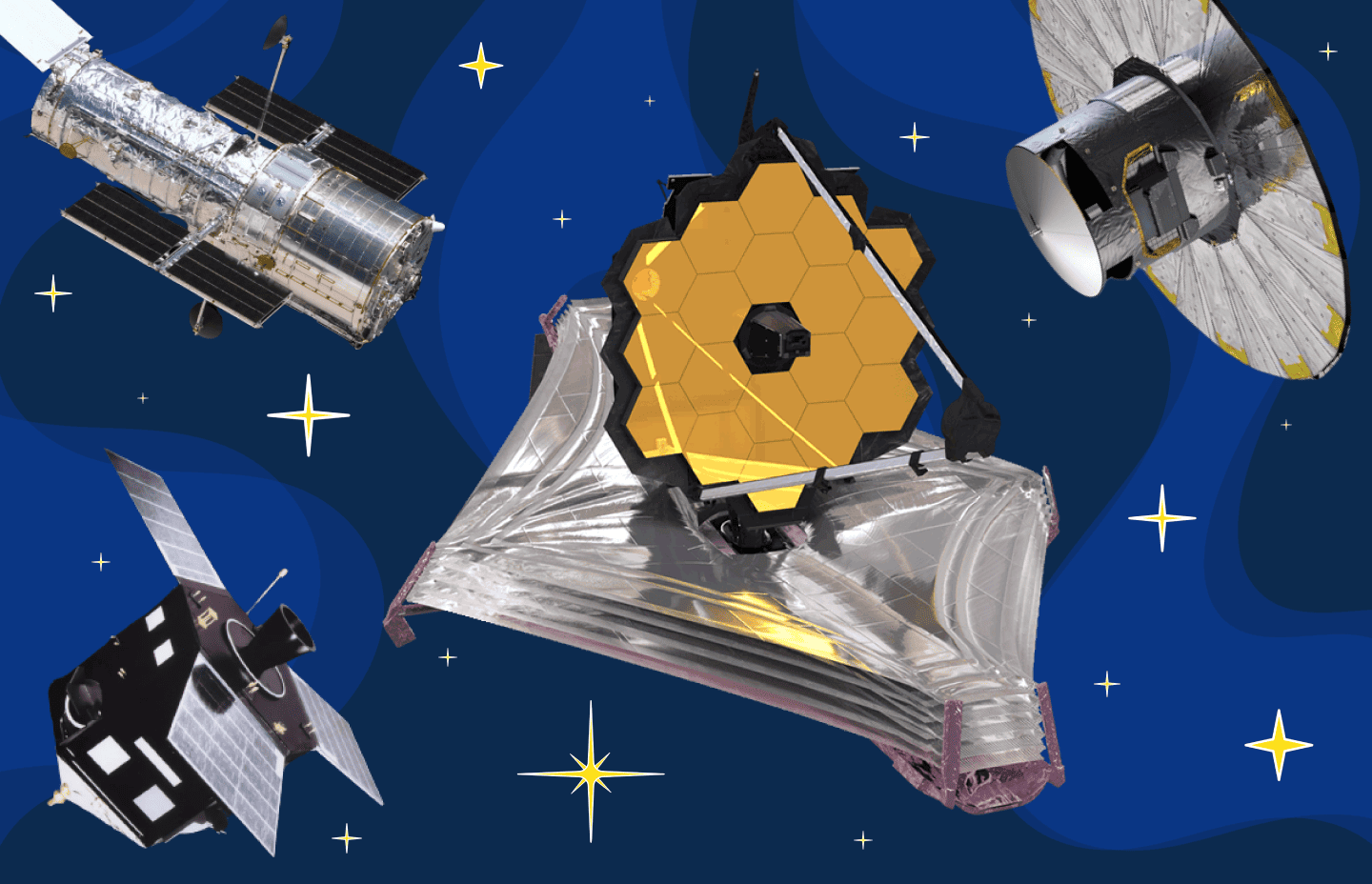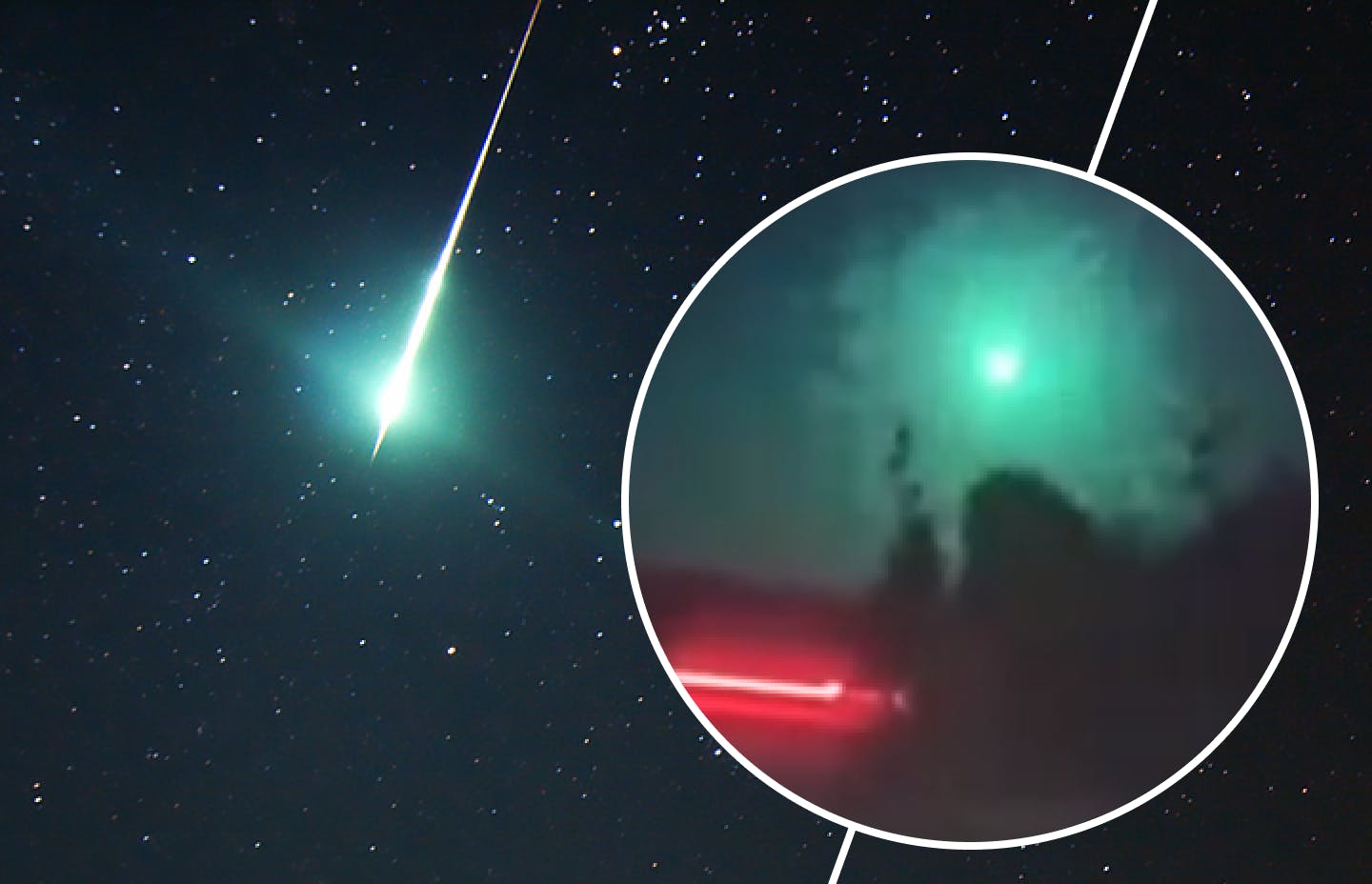 794
794
New times require new technologies: a review of space super telescopes!

On August 25, 1609, Galileo Galilei demonstrated to the world a new device – a telescope with two lenses, which tripled the magnification of the observed objects. Later, a new improved telescope could magnify objects 33 times, which allowed him to discover the moons of Jupiter, craters on the Moon, and detect a multitude of stars that form the Milky Way. Over more than 400 years, this device has come a long way in evolution and hundreds of improvements. It has received dozens of varieties and optical schemes ... but let's take it step by step.
A small invention that makes great discoveries
The earliest schematic mention of a telescope with two lenses was found in the drawings of Leonardo da Vinci (16th century). However, it is currently not proven whether the great scientist created at least one of such devices. Mentions of the telescope were also found in the works of the English philosopher Roger Bacon (13th century), but here also we have no formal confirmation of the existence of a physical prototype – hence, the inventor of the «object that brings distant things closer» is considered to be the Dutchman of German origin Hans Lippershey. He created a telescope that ... was not unique.
Lippershey was unable to patent the invention, as similar devices were also owned by Dutchmen Zacharias Janssen and Jacob Metius: they also created telescopes that as well consisted of two lenses (convex and concave) and magnified observed objects three times. Eventually, Dutch telescopes spread across Europe and, according to legend, Galileo Galilei built his own in one night by placing two lenses in a lead tube.
In the second half of the 17th century, telescopes were invented by Johannes Kepler, who proved that using two convex lenses is more efficient than an optical system with one convex and one concave lens. In 1668, Isaac Newton constructed his first reflecting telescope with a 38-fold magnification. Today, there are dozens of types of telescopes, depending on their design features. Each of them is used for a specific range of studies. Even though it is possible to build telescopes with mirrors and lenses of various sizes on the surface of the Earth, not all astronomical observations can be carried out from the surface of our planet due to the influence of various factors, including our atmosphere, which has the property of blurring the image. Also, radiation with some ranges of wavelengths does not pass through the atmosphere at all.
Observations in outer space are not hindered by the atmosphere, so at the end of the 20th century, with the development of space exploration, telescopes began to be launched into orbit around Earth. Every day, space observatories and huge teams work tirelessly and carry out critical missions, so we want to briefly tell you about the missions and scientific results of these giants!
High-Precision Parallax Collecting Satellite (Hipparcos)
History. Launched in 1989 by the European Space Agency, Hipparcos became the first space mission dedicated to precision astrometry, i.e., the accurate measurement of the positions of celestial objects. It was originally designed to determine the positions, parallaxes, and annual proper motions of about 100,000 stars with an astrometric accuracy of 2 milli arcseconds (often shortened as mas). The results exceeded expectations: parameters were obtained for ~120,000 stars in total, and the average accuracy was about 1 milli arcsecond.
Mission. The mission lasted for 3.5 years. During this time, it was possible to collect information about more than a million stars. Astronomers discovered over 8,000 variable stars and over 3,000 binary stars and determined five astrometric parameters for about 120,000 objects (celestial coordinates, parallax, proper motion) with an accuracy that exceeds the accuracy of ground-based observations by a hundred times! Some of the results are not only more accurate but rather fundamentally new. For example, the determined parallaxes are absolute, not relative, as it was during observations from Earth’s surface. The accuracy of the measurements allowed us to significantly refine the distances to the stars.
Achievements. Hipparcos made over 3 million observations during its main program, which covered almost all stars up to 8.5 magnitudes; it was later expanded to several tens of millions of observations. Thanks to them, astronomers collected photometric and astrometric data for all stars up to about eleventh magnitude. A major achievement was also the first in the world observation of a million stars in a single photometric system. Today, only Hipparcos's successor, GAIA (several billion stars), and TESS, which has a different purpose (about 650,000 stars as of October 2023), have similar scales of observations. Hipparcos conducted observations in the B and V filters of the UBV system.
Interesting facts. The results of Hipparcos were so revolutionary that they completely changed the course of development of the entire section of astronomical research – astrometry. The fundamental catalog of stellar positions was much more accurate and larger than ground-based ones, so rapidly all researchers using stellar coordinates and parallaxes began to prefer the results of Hipparcos. Over the following years, ground-based and space astronomy coexisted, and gradually the second supplanted the first. The next astrometric revolution will take place in 2013 with the launch of Hipparcos' successor, the Gaia observatory. Since then, ground-based astrometry has become a thing of the past, giving way to space astrometry.
Global Astrometric Interferometer for Astrophysics (GAIA)
History. Gaia is a space telescope of the European Space Agency, launched in the winter of 2013. Less than a month later, the spacecraft reached its designated orbit near the Lagrange point L2 of the system Earth-Sun. Initially, the duration of the Gaia mission was planned until the summer of 2019, however it was extended to the end of 2025. The telescope has exceptional construction features: its main instrument is a digital sensor with almost a billion pixels, the largest ever created for space missions.
Mission. Truly unique! Its main goal is to determine the position of about 2 billion objects. In the future, it is planned to create the largest and most accurate 3D map of the Milky Way. In general, the Gaia telescope is designed for astrometry: measuring the positions, distances, and motion of stars, as well as the positions of exoplanets orbiting the observed stars.
Achievements. Gaia is more accurate than its predecessor and studies a thousand times more objects than Hipparcos. Currently, Gaia performs the most accurate astrometry of all existing telescopes: about 20 micro arcseconds for 15th stellar magnitude and 200 micro arcseconds for 20th stellar magnitude. The advantages and achievements do not end there: previously, more than 99.9% of the objects observed by Gaia had never had their exact distance measured. In addition, this telescope is capable of measuring the coordinates of stars up to 20th stellar magnitude.
Perspectives. In the coming years, Gaia will conduct the largest in human history:
- low-resolution spectroscopic study.
- measurement and study of radial velocities.
- collection of astrophysical data for stars of the Milky Way.
- study of many classes of variable stars.
By the end of the mission, the data archive will exceed 1 petabyte (1 million gigabytes). Three data catalogs have been released to date, the latest of which was published in open access in June 2022. Each contains the positions and magnitudes of over 1 billion stars. The third catalogue is called DR3 and is the richest one, containing 1.8 billion objects.
Interesting facts. During the publication of the data, there were some curiosities. Since the amount of information was simply fantastic, the data analysis was carried out in automatic mode, and the verification of the results manually took some time. Therefore, in the first release of the data (Gaia DR1), there was a certain percentage of stars for which negative parallaxes were indicated. That is, the distance to these objects according to the Gaia results was calculated as negative...
However, nothing critical happened, since no one is insured against calculation errors. «Sh*t happens» said the Gaia mission team, which published the first catalog and soon, in the second release, corrected all the calculation errors they found. Therefore, as of 2023, the coordinates, parallaxes, and proper motions of objects obtained by Gaia are considered to be the most accurate in the entire observation history.
Hubble Space Telescope (HST)
History. Without exaggeration, a legendary telescope that everyone has heard of and that needs virtually no introduction. A telescope that (like Edwin Hubble himself) expanded and changed our understanding of the Universe. A telescope that has appeared in more movies than any other.
HST is an American optical telescope developed jointly by NASA and ESA. Launched into Earth orbit on April 24, 1990. It is a unique multipurpose orbital observatory, the largest launched into space in the 20th century (diameter of the main mirror – 2.4 m). It can observe in the ultraviolet, visible and infrared ranges.
Mission. For over 30 years of operation, Hubble has made more than 1.5 million observations. On their basis, astronomers have published over 19,000 scientific papers. This makes HST one of the most productive scientific instruments ever created. Hubble orbits in low Earth orbit, «photographing» stars, planets, and galaxies, moving around the Earth at a speed of about 27,000 km/h.
Achievements. This space telescope was able to look into the distant past, into places that are more than 13.4 billion light-years away from Earth. To list and briefly describe the significance of all the telescope's achievements, a separate article is needed. Therefore, we will only list a few of them:
- The first maps of the surface of Pluto (then still a planet) were obtained.
- The value of Hubble's constant was calculated with an accuracy of 10%.
- The accelerated expansion of the universe was discovered.
- Thanks to it, the galaxy GN-z11 was discovered, which as of 2016 was considered the most distant of all known objects in the Universe!
Annually, HST generates about 10 terabytes of new data (the total size of the archive currently exceeds 340 TB). At the end of 2021, the JWST, an American orbital infrared space telescope, was sent to help HST in carrying out NASA's main mission in astrophysics; in January 2022, it reached the Lagrange point «Sun-Earth» L2.
Interesting facts. From the very beginning, the mission was on the verge of failure due to a defect in the mirror. However, since the telescope was launched into low Earth orbit, several missions were launched to address technical problems, and later to modernize the telescope. Maintenance was carried out by teams of astronauts, who were «delivered» to orbit using the reusable Space Shuttle spacecraft. The last repair and modernization expedition was carried out in May 2009. In 2013, it was planned to launch the James Webb Space Telescope, which would become a full-fledged successor to Hubble, and the telescope itself would be sunk in the ocean. However, things did not go as planned…
James Webb Space Telescope (JWST)
History. Unlike HST, the James Webb Space Telescope can observe in a lower frequency range: from long-wave visible light to the middle infrared. This allows JWST to observe objects with high redshift, which are too old and too distant to be observed by HST.
Mission. The main scientific tasks of the Webb telescope are to study the processes of galaxy formation in the early Universe, the processes of star formation; the search and study of exoplanets, including those that are suitable for life.
Achievements. Currently, JWST is the largest (main mirror diameter is 6.5 m) and most sensitive (exceeded its predecessor HST by 100 times) space telescope in human history! It is also considered one of the most important projects in astronomy in the 21st century. The quality of the images taken by JWST is striking. In July 2022, the first high-resolution colour image was shown: it showed astronomers the galaxy GLASS-z13, which is about 13.5 billion years old. This galaxy is currently considered the oldest ever discovered.
Interesting facts. The James Webb Space Telescope (JWST) has faced a thorny path of development, testing, and ... numerous changes in the launch date. It was postponed 15 times due to numerous delays as a result of a small initial budget, planning errors by the NASA leadership, as well as problems with design and manufacturing. In general, these delays and the unevenness of financing only increased the cost of the project from $500 million to almost $10 billion. However, the launch of the telescope finally did take place in December 2021. Repair of the telescope was not originally planned, since its distance from Earth is over 2 million kilometers, which is 5 times further than a person has ever been from Earth. Nevertheless, the James Webb is currently operating without serious failures and has already provided humanity with a huge amount of data, thanks to which numerous discoveries have been made.
Summary
All four telescopes have been revolutionary in their niches, forever changing them. And it is worth saying something else – most of the observations of these space telescopes, as well as almost two dozen smaller space missions that are not listed in this article, are publicly available.
Anyone can download observations of space telescopes from the MAST (Mikulski Archive for Space Telescopes) archive at the following link.
Also, we recommend that you familiarize yourself with the article «List of Space Telescopes» created by our Wikipedia department, which belongs to the Featured Lists of the Ukrainian Wikipedia.
Looking at the achievements of Hipparcos, Gaia, HST, and JWST, it becomes clear that well-planned research can lead to results that can start a new era in science. Ahead of us are even more incredible discoveries, and perhaps very soon we will obtain new information that will entirely change our understanding of the Universe!
See you soon and to the new discoveries!



